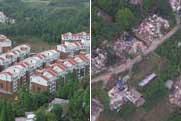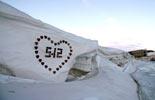China
Postive comments numerous on China´s Tibetan exhibit as visitor numbers exceed 100,000
Source: Xinhua | 06-19-2008 16:29
Special Report: Tibet: Past and PresentSpecial Report: Tibet Today
BEIJING, June 19 (Xinhua) -- For retired colonel Zhang Yongxin, the large-scale exhibition "Tibet, the Past and the Present" impressed him as both informative and inclusive.
With 160 exhibits and more than 400 pictures, the exhibition, held in two halls of the Cultural Palace for Nationalities in downtown Beijing, consisted of two parts: the "History of Tibet and Feudal Serfdom in Old Tibet" and "New Tibet Changing With Each Passing Day."
For 75-year-old Zhang, it was his second trip to the show, which opened on April 30 and was expected to run through late July.
On his previous visit, the local man took a "careful" and "thorough" view of the displays, but the facts and figures had faded from his memory on his return.
"This time, I brought a notebook with me," he said, while jotting down facts and figures that showed Tibet was a part of Chinese territory since the Yuan Dynasty (1279-1368).
Even with a hearing aid, Zhang had to get closer to others to listen clearly, but this did not stop him from making a lengthy tour he considered very "knowledge intensive."
"I was a soldier in 1951 when the 'Seventeen-Article Agreement' was signed (between the central government and the local government of Tibet for the peaceful liberation of the now autonomous region), and these all proved Tibet has always been a part of China," he said.
"Life in today's Tibet is way better than in the past. Some of the Western media's recent coverage on Tibet is groundless," he added.
In another hall titled "New Tibet Changing With Each Passing Day," Tang Yongqiang was discussing something with his mother. The high-school student from the neighboring Hebei Province had just finished his college entrance examination earlier this month.
"The exhibition is well worth the time. It is so vivid that I feel as if I was a witness," the youngster said.
He left a note in the visitor's book reading " May Tibet become more prosperous together with the big family of China, and stop those secessionist activities from sabotaging people's lives."
The youngster was not the only one to leave a note.
Since its opening on April 30, the exhibition has hosted over 100,000 visitors. Hundreds of them, both Chinese and foreigners, had left notes on Tibet and the exhibition, said Han Xinbo, the museum office director.
Organized visits of students, army officers and government staff accounted for nearly half the total, he said.
As reporters leafed through the book, the messages were unanimously positive.
"A wonderful insight into Tibet. This helps outsiders form a correct view. I really enjoyed the exhibition," wrote Ken Mclnnes of Sydney, Australia.
Devendra Dhuagaua from Nepal's NTV wrote "Tibet has been transformed from rags to riches and the Chinese government deserves all praise for the positive changes brought to the people of Tibet."
Only one visitor named Nick Coti from Alaska, USA, put forward a suggestion. He asked the museum authorities to offer English guides and add English captions for the video shown upstairs.
In a room upstairs, dozens of viewers, including one foreigner, were watching a video on Tibetan history. Even during lunchtime, most of the seats were taken.
Watching the footage of the Dalai Lama's engagement in the 1950s with China's top leaders Chairman Mao Zedong and Premier Zhou Enlai was very fresh and informative, said one visitor.
In one of the scenes, the Dalai Lama was making a passionate speech at the First Session of the First National People's Congress held in Beijing in September 1954.
Documentary-like pictures and film clips also showed tools used by serf owners to torture people in Tibet before the 1951 liberation.
Eye-gouging tools, an image of dismembered arms and human skin formed a sharp contrast with the hall downstairs, where vivid pictures of modern Tibet were displayed.
"Thousands of years of serfdom in Tibet made the kind people there suffer," wrote visitor Xiao Wenda. "After the liberation, those people have started their lives anew with goodness and blessings."
Editor:Zhang Ning



